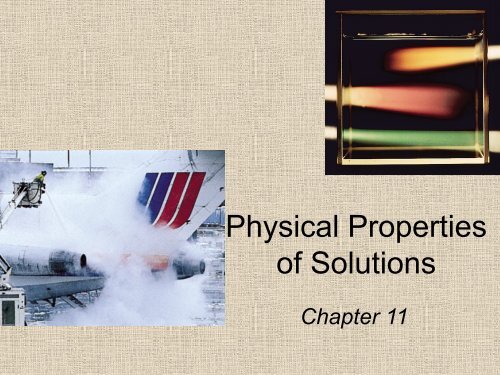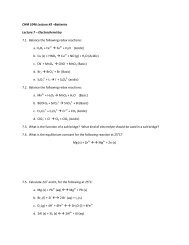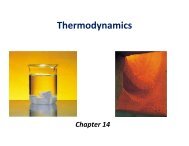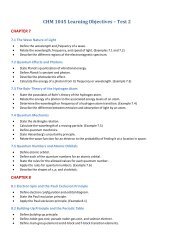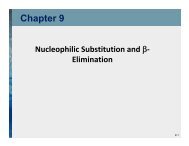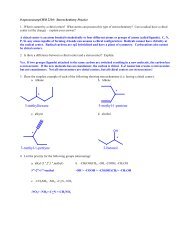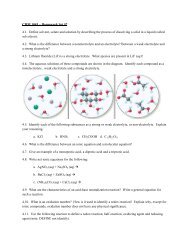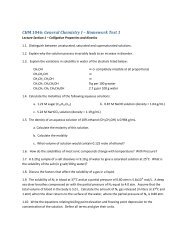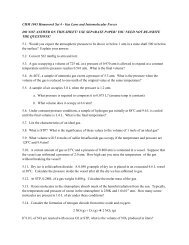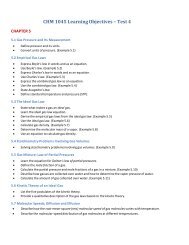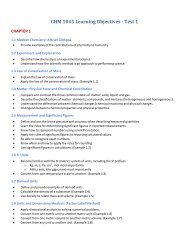Chapter 14 - Colligative Properties
Chapter 14 - Colligative Properties
Chapter 14 - Colligative Properties
Create successful ePaper yourself
Turn your PDF publications into a flip-book with our unique Google optimized e-Paper software.
Physical <strong>Properties</strong>of Solutions<strong>Chapter</strong> 11
A saturated solution contains the maximum amount of asolute that will dissolve in a given solvent at a specifictemperature.An unsaturated solution contains less solute than the solventhas the capacity to dissolve at a specific temperature.A supersaturated solution contains more solute than is presentin a saturated solution at a specific temperature.Sodium acetate crystals rapidly form when a seed crystal isadded to a supersaturated solution of sodium acetate.11.7
Three types of interactions in the solution process:• solvent‐solvent interaction (breaking IMF)• solute‐solute interaction (breaking IMF)• solvent‐solute interaction (called Solvalysis, making IMF)ΔH soln = ΔH 1 + ΔH 2 + ΔH 311.7
“like dissolves like”Two substances with similar intermolecular forces are likely to besoluble in each other.• non‐polar molecules are soluble in non‐polar solventsCCl 4 in C 6 H 6• polar molecules are soluble in polar solventsC 2 H 5 OH in H 2 O• ionic compounds are more soluble in polar solventsNaCl in H 2 O or NH 3 (l)11.7
Concentration UnitsThe concentration of a solution is the amount of solutepresent in a given quantity of solvent or solution.Percent by Massmass of solute% by mass = x 100%mass of solute + mass of solventMole Fraction (X)mass of solute= x 100%mass of solutionX A =moles of Asum of moles of all components11.7
Molarity (M)Concentration Units ContinuedM =moles of soluteliters of solutionMolality (m)m =moles of solutemass of solvent (kg)11.7
Molality ProblemCalculate the molality of a solution of 13.5g ofKF dissolved in 250. g of water.m=mol of solutekg solvent=1 mol KF⎜ ⎟⎝ 58.1 ⎠0.250 kg( 13.5g) ⎛ ⎞0.929 m11.7
What is the molality of a 5.86 M ethanol (C 2 H 5 OH) solutionwhose density is 0.927 g/mL?m =moles of solutemass of solvent (kg)M =moles of soluteliters of solutionAssume 1 L of solution:5.86 moles ethanol = 270 g ethanol927 g of solution (1000 mL x 0.927 g/mL)mass of solvent = mass of solution –mass of solute= 927 g – 270 g = 657 g = 0.657 kgm =moles of solutemass of solvent (kg)= 5.86 moles C 2H 5 OH0.657 kg solvent= 8.92 m11.7
Mole Fraction• Mole fraction (χ) is the ratio of the numberof moles of a substance over the totalnumber of moles of substances in solution.χ=inumber of moles of itotal number of moles11.7
Mole Fraction ProblemCalculate the mole fraction of 10.0g of NaCldissolved in 100. g of water.χ =NaClmol of NaClmol of NaCl + mol H O2=⎛1 mol NaCl ⎞( 10.0g)⎜⎟⎝ 58.5g NaCl ⎠⎛1 mol NaCl ⎞ ⎛1 mol H ⎞⎜⎟ +2O2 ⎜ ⎟⎝58.5g NaCl ⎠ ⎝ 18.0g H2O⎠( 10.0g) ( 100.g H O)= 0.029911.7
Temperature and SolubilitySolid solubility and temperaturesolubility decreases increases withincreasing temperature11.8
Fractional crystallization is the separation of a mixture of substancesinto pure components on the basis of their differing solubilities.Suppose you have 90 g KNO 3contaminated with 10 g NaCl.Fractional crystallization:1. Dissolve sample in 100 mL ofwater at 60 0 C2. Cool solution to 0 0 C3. All NaCl will stay in solution (s =34.2g/100g)4. 78 g of PURE KNO 3 willprecipitate (s = 12 g/100g). 90g –12 g = 78 g11.8
Temperature and SolubilityGas solubility and temperaturesolubility usually decreaseswith increasingtemperature11.8
Pressure and Solubility of Gases• Henry’s LawP gas = k gas C gasP gas = pressure of the gas above the solutionC gas = concentration of the gask gas = Henry’s law constantlow Phigh Plow chigh c11.8
Henry’s Law ProblemA liter of water dissolves 0.0404 g of oxygen at 25 o Cat a pressure of 760. torr. What would be theconcentration of oxygen (in g/L) if the pressurewere increased to 1880 torr at the sametemperature?P gas = k gas C gas or P gas C gas = k gasSince the ratio is equal to a constant, 2 conditionscan be set equal.P1 P2=C C1 2C 20.0404 g/L =760. torr 1880 torrC2= 0.0999 g/L11.8
<strong>Colligative</strong> <strong>Properties</strong><strong>Colligative</strong> properties are properties that depend only on thenumber of solute particles in solution and not on the nature ofthe solute particles.11.9
<strong>Colligative</strong> <strong>Properties</strong> of Nonelectrolyte Solutions• Vapor pressure lowering –the vaporpressure of a solvent is lowered by theaddition of a nonvolatile solute.P 1 = X 1 P 10Raoult’s lawP 1 0 = vapor pressure of pure solventX 1 = mole fraction of the solventIf the solution contains only one solute:X 1 = 1 – X 2P 1 0 - P 1 = ΔP = X 2 P 10X 2 = mole fraction of the solute11.9
V.P. Lowering ProblemWhat will be the vapor pressure of a solution made bydissolving 6.25g of glucose, C 6 H 12 O 6 , in 50.0g of water at25 o C? How much was the vapor pressure of the purewater lowered? The vapor pressure of water at 25 o C is23.8 torrmol glucose = 6.25 g( )( )P = χ P o = 0.988 23.8 torr = 23.5 torrsoln water water⎛ 1 mol ⎞⎜ ⎟ = 0.0347 mol glucose⎝180. g ⎠⎛1 mol ⎞mol water = 50.0 g ⎜ ⎟ = 2.78 mol water⎝18.0g⎠2.78χwater= = 0.9880.0347+2.78vapor pressure lowering = 23.8 torr - 23.5 torr = 0.2 torr11.9
Ideal SolutionP A = X A P A0P B = X B P B0P T = P A + P BP T = X A P A0+X B P B011.9
P T is greater thanpredicted by Raoults’s lawP T is less thanpredicted by Raoults’s lawForceA-BForceA-A< &ForceB-BForceA-BForceA-A> &ForceB-B11.9
Boiling-Point ElevationΔT b = T b – T b00T b is the boiling point ofthe pure solventT b is the boiling point ofthe solutionT b > T b0ΔT b > 0ΔT b = K b mm is the molality of the solutionK b is the molal boiling-pointelevation constant ( 0 C/m)11.9
Freezing-Point Depression0ΔT f = T f0T fT f0T f > T f– T fis the freezing point ofthe pure solventis the freezing point ofthe solutionΔT f > 0ΔT f = K f mm is the molality of the solutionK f is the molal freezing-pointdepression constant ( 0 C/m)11.9
11.9
What is the freezing point of a solution containing 478 gof ethylene glycol (antifreeze) in 3202 g of water? Themolar mass of ethylene glycol is 62.01 g.m =ΔT f = K f mmoles of solute=mass of solvent (kg)K f water = 1.86 0 C/m478 g x1 mol62.01 g3.202 kg solvent= 2.41 mΔT f = K f m = 1.86 0 C/m x 2.41 m = 4.48 0 C0ΔT f = T f– T f0T f = T f– ΔT f= 0.00 0 C – 4.48 0 C = -4.48 0 C11.9
Osmotic Pressure (π)Osmosis is the selective passage of solvent molecules through a porous membranefrom a dilute solution to a more concentrated one.A semipermeable membrane allows the passage of solvent molecules but blocks thepassage of solute molecules.Osmotic pressure (π) is the pressure required to stop osmosis.П = iMRTi= sum of the coefficients of the ions (i= 1 for molecular compounds)M = molarityR = gas constant (0.0821 L • atm/mol • K)T = temperature in Kelvin11.9
A cell in an:isotonicsolutionhypotonicsolutionhypertonicsolution11.9
Osmotic Pressure ProblemWhat is the osmotic pressure of a 100.0 mLsolution containing 9.50 g of glucose, C 6 H 12 O 6 , at20.0 o C?⎛ 1 mol ⎞mol glucose = 9.50 g ⎜ ⎟=0.0528 mol⎝180. g ⎠0.0528 molMglucose= = 0.528 mol/L0.100 L⎛ L⋅atm ⎞π = (1)( 0.528 mol/L) ⎜0.08206 ⎟( [20.0+273] K ) = 12.7 atm⎝ K⋅mol⎠11.9
<strong>Colligative</strong> <strong>Properties</strong> of Nonelectrolyte Solutions<strong>Colligative</strong> properties are properties that depend only on the numberof solute particles in solution and not on the nature of the soluteparticles.Vapor-Pressure Lowering P 1 = X 1 P 10Boiling-Point ElevationFreezing-Point DepressionOsmotic Pressure (π)ΔT b = K b mΔT f = K f mπ = MRT11.9
<strong>Colligative</strong> <strong>Properties</strong> of Electrolyte Solutions0.1 m NaCl solution 0.1 m Na + ions & 0.1 m Cl - ions<strong>Colligative</strong> properties are properties that depend only on thenumber of solute particles in solution and not on the nature ofthe solute particles.0.1 m NaCl solution 0.2 m ions in solutionvan’t Hoff factor (i) =actual number of particles in soln after dissociationnumber of formula units initially dissolved in solnnonelectrolytesNaClCaCl 2i should be12311.9
<strong>Colligative</strong> <strong>Properties</strong> of Electrolyte SolutionsBoiling-Point ElevationFreezing-Point DepressionOsmotic Pressure (π)ΔT b = i K b mΔT f = i K f mπ = iMRT11.9


